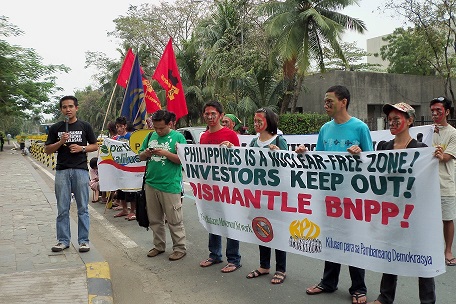Research Project towards a Proposal for Alternative Uses of Bataan Nuclear Power Plant (BNPP) Facility.
 |
Nuclear Free Bataan Movement - Network |
 |
Chester Amparo |
 |
|
 |
JPY 250,000 |

Plead against nuclear event
Research Background
BNPP is a 357- hectare facility at Napot Point in Morong, Bataan. The Plant was built byWestinghouse Electric Co. from 1974 to 1984 at the cost of USD 2.3 Billion or four times the initial bid of USD 600 Million.
Right from the start, the project already met strong opposition from the Filipino people. Scientific studies had shown that it was potentially dangerous. For many, it was a monument of greed and corruption of the two-decade-old dictatorship.
At the height of the anti-BNPP campaign, the province of Bataan had screeched to a halt, with thousands of people taking to the streets in opposition. It also generated local and international support. After the people power that finally toppled the Marcos dictatorship, President Corazon Aquino mothballed the plant.
In July 2008, Rep. Mark Cojuangco, the son of businessman Eduardo Cojuangco, drafted the House Bill 4631 which calls for the 'rehabilitation, commissioning and commercial operation' of the Bataan Nuclear Power Plant or BNPP. Unlike the earlier BNPP-related proposal, 192 out of 228 members of the House of Representatives supported the HB 4631.
Once again, the people registered their opposition. Commissioning the BNPP is dangerous and absolutely deadly. Paying for it would not only be burdensome for the public but also outrageous.
These were the salient points presented by NFBM-Net and the rest of those in the opposition:
1. The location of the BNPP makes it vulnerable to earthquakes, faulting and volcanic eruptions. It sits right on Mt. Natib, a caldera-forming volcano like Mt. Pinatubo, which makes up the whole northern Bataan Peninsula. It is very near the Manila Trench-Luzon and the tectonic structures are bracketed by significant and very strong (high magnitude) historic earthquakes within a hundred kilometer radius.
2. Experts found the BNPP structure and design riddled with defects.
A series of technical audits in 1986, 1988 and 1990 conducted by the National Union of Scientists revealed this - the plant has 'serious defects in its cover design, construction, quality assurance, workmanship and project management. The report also commented on the lack of allotment for auxiliary expenses such as cost of insurance, training, permanent disposal of nuclear wastes, decommissioning, emergency planning and accidents.
3. Toxic and environmental pollutants have been attributed to the presence of nuclear power plants. Many radioactive elements taken in by humans (and even by animals) have a tendency to accumulate in certain parts of the body such as Iodine-131 (thyroid glands), strontium-90 (bones) and cesium-137 (muscles).
4. If the plant becomes operational, the disposal of wastes-- averaging 20-30 tons a year, would be a problem. The Philippine Atomic Energy Commission (PAEC) had articulated this as far back as 1977. Science and Technology has yet to find a permanent and safe disposal of radioactive waste from the Nuclear power plants.
5. The BNPP would also destroy the marine life in the nearby water bodies that will be used as coolant for its reactors. The water temperature would heat up and would make marine life impossible to exist.
Until February this year, the bill that would have led to the commissioning of the BNPP was gathering support from among the members of the House of Representatives. At that time the newly installed administration was considering proposals for a program for the nuclear energy development in the country. But the situation had changed after the nuclear power disaster in Fukushima.
The bill filed during the 14th Congress by Rep. Mike Cojuangco and its counterpart bill in the Senate has not been filed again in the 15th Congress. And now, while the government has announced that it is readying for a nuclear plant conversion, it has also reported that San Miguel Corporation, a company with majority shares owned by the Cojuangco's, has expanded business interests in energy, and may possibly buy the government property.
The groups that opposed the commissioning of the BNPP have a general suggestion to transform the BNPP into a facility for generating environmentally safe and renewable energy.
But scientist groups have shown that the conversion of BNPP into either a fossil oil plant, a coal-fired plant or a combined cycle plant are much more expensive, thus, making it non-viable compared to merely upgrading the plant, meaning, repairing the parts that have been eroded through the years and correcting the defects.
Initially, NFBM and some environmentalist groups and individuals see BNPP being maximized for educational use. It will primarily be an educational tour destination and a subject for critical study of engineering students and of the ordinary people while the areas surrounding the facility will be open for cooperative agricultural development.
But this option requires research to firm up its basis and debunk the proposals to convert BNPP into a facility for energy generation.
[Sep. 2011]
